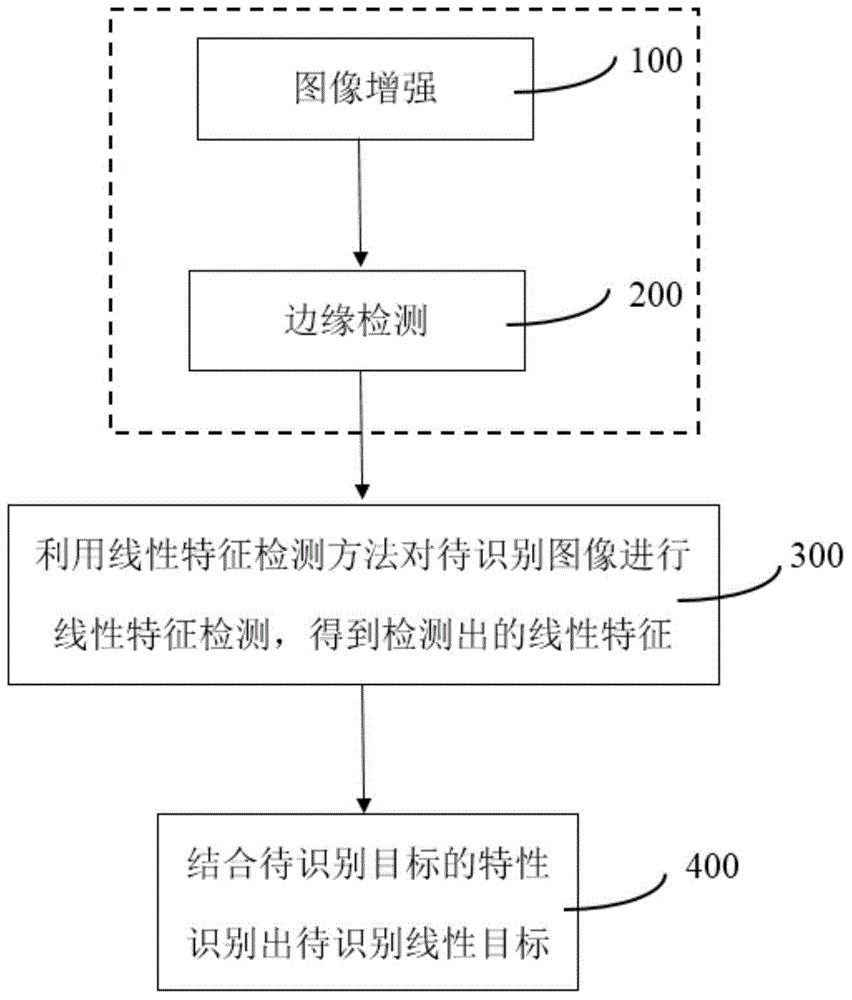Target recognition method and device
A target recognition and target technology, applied in the field of image processing, can solve problems such as insufficient ability, strong environmental noise and system noise, complex background, etc., to prevent misjudgment and suppress system noise and environmental noise.
- Summary
- Abstract
- Description
- Claims
- Application Information
AI Technical Summary
Problems solved by technology
Method used
Image
Examples
example 1
[0066] Figure 4 (a) shows a synthetic image with a real satellite image as the background, which includes forests, buildings, roads, etc. There are two power lines from the upper left to the lower right in the image, and the two roofs in the left middle and upper right corner of the background of the image are high-brightness planar targets. Figure 4 (b) shows the results of linear feature detection using traditional Radon transform, where almost all false straight lines are caused by bright planar objects. Figure 4 (c) The result of linear feature detection using traditional Radon transform after edge detection. From Figure 4 (c) It can be seen that although the false straight lines caused by bright planar targets are successfully eliminated, there are a large number of false straight lines caused by forest land in the detection results. Figure 4 (d) shows the result of linear feature detection using the method of the present invention after edge detection. From Fi...
example 2
[0068] Figure 5 The composite image of (a) includes short line segments to simulate the wake of a ship, and this V-shaped wake is found to be useful for tracking the ship. Gaussian noise pair with variance equal to 5 Figure 5 (a) Perform noise processing to get Figure 5 (b) The image to be processed. Using the target recognition method proposed by the present invention to Figure 5 (b) After target recognition, get the following Figure 5 (c) The results shown. From Figure 5 (c) It can be seen that the method of the present invention can also successfully identify short line segments. Figure 5 (d) and Figure 5 (e) respectively show the two-dimensional distribution in Radon space when using traditional Radon numbering to perform linear feature detection and using the method of the present invention to perform linear feature detection. By comparing the two figures, it can be seen that the method of the present invention effectively suppresses the noise and enhances...
example 3
[0070] Figure 6 (a) is the original image to be processed, which is a GeoEye-1 remote sensing image with a resolution of 512×512. From Figure 6 In (a), it can be seen that there is a power line diagonally across the image from the north to the southeast on the remote sensing image. The background is very complex, including bare land, roads, substations, and large forests in the south. There is a lot of noise, which increases the identification and recognition of power lines. extraction difficulty. The result of edge detection is as follows Figure 6 As shown in (b), it can be seen that a large amount of system noise exists. Figure 6 (c) shows the result of target recognition using the method of the present invention. From Figure 6 It can be seen in (c) that in addition to the power lines of interest, the road information of the image to be processed is also extracted. At this time, in order to further extract the power lines to be extracted, the following characteris...
PUM
 Login to View More
Login to View More Abstract
Description
Claims
Application Information
 Login to View More
Login to View More - R&D
- Intellectual Property
- Life Sciences
- Materials
- Tech Scout
- Unparalleled Data Quality
- Higher Quality Content
- 60% Fewer Hallucinations
Browse by: Latest US Patents, China's latest patents, Technical Efficacy Thesaurus, Application Domain, Technology Topic, Popular Technical Reports.
© 2025 PatSnap. All rights reserved.Legal|Privacy policy|Modern Slavery Act Transparency Statement|Sitemap|About US| Contact US: help@patsnap.com



